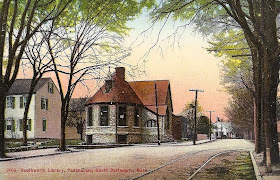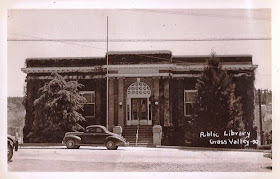[LIB11206] - Bookmobiles are still in use, operated by libraries, schools, activists, and other organizations. Although some feel the bookmobile is an outmoded service, giving reasons like high costs, advanced technology, impracticality, and ineffectiveness, others cite the ability of the bookmobile to be more cost-efficient than building more branch libraries would be and its high use among its patrons as support for its continuation.
This blog represents a collection of postcards that focuses on libraries in the United States and throughout the world.
Pages
▼
Monday, November 24, 2014
Sandhills Regional Library Bookmobile, Wooster, Ohio
[LIB11206] - Bookmobiles are still in use, operated by libraries, schools, activists, and other organizations. Although some feel the bookmobile is an outmoded service, giving reasons like high costs, advanced technology, impracticality, and ineffectiveness, others cite the ability of the bookmobile to be more cost-efficient than building more branch libraries would be and its high use among its patrons as support for its continuation.
Raymond Library, Montville, Connecticut
[LIB11205] - When Albert C. Raymond of Montville and East Hartford died in 1880, he left $10,000 in trust for the establishment of a library in Montville. A library had existed in Montville Center as early as 1823: the Union Library, a private institution located in an old store on the site of the present Congregational Church. As described in Henry A. Baker’s History of Montville (1896),
After the death of Mrs. Raymond, 16 Sept., 1883, the sum donated for the founding of the Raymond Library was received from the executors of the estate of Albert C. Raymond by the Raymond Library Company, who immediately caused a library building to be erected at a cost of two thousand dollars. The building was a beautiful brick structure, built under a contract by Mr. Robert Turner of Norwich, and completed in the winter of 1884-5. At the annual meeting of the Raymond Library Company, held October 14, 1885, the library building was formally opened to the public; a bountiful collation was prepared by the ladies of the town, which was partaken of and heartily appreciated by all the persons who gathered at the chapel of the Congregational church at Montville Center on the occasion.
The Raymond Library has since been expanded with some very obvious modern additions. [Website]
Carnegie Library, Greenpoint, Brooklyn, New York
[LIB11200] - The original Greenpoint Branch, opened in 1906, was one of the first Carnegie Libraries to be constructed in the rapidly expanding Brooklyn Public Library system. Designed by architect R. L. Daus, the building occupied a corner lot at 107 Norman Avenue. The Greenpoint Star praised the library for its elegant simplicity, its golden oak woodwork and fine brasswork, and the Brooklyn Eagle noted reading rooms that were tastefully decorated with potted palms.
By the 1930s excessive dampness and subsidence were causing the building to deteriorate. In 1970 the Department of General Services decided it would be too costly to renovate the building and tore it down.
A new building on the site of the original Carnegie building opened on December 20, 1973. [Website]
Woman and Library Card Catalog
A reproduction of this card is available through my Zazzle store, $1.00 each.
Friday, November 21, 2014
Public Library, Danville, Virginia
[LIB11199] - Danville Public Library, also known as the William T Sutherlin Mansion and the Confederate Memorial, is a historic home and library building located at Danville, Virginia. It was built for Major William T. Sutherlin in 1857-1858, and is a two-story, five-bay, stuccoed building in the Italian Villa style. It was listed on the National Register of Historic Places in 1969. [Wikipedia]
Barrett Friendly Library, Mountain Home, Pennsylvania
[LIB11198] - Completed 1914. The above excerpt is from Pennsylvania Library and Museum Notes, Volumes 1-8 (Google eBook).
Public Library, East Orange, New Jersey
[LIB11196] - At the first meeting of that Board, a letter from Andrew Carnegie was read offering $50,000.00 for the construction of a library building if the City would provide a site and maintenance of not less than $5,000.00 a year for the library. The land, at the corner of Munn Avenue and Freeway Drive East (then Main Street), was purchased at a cost of $22,182.00, and the building was designed by Kent, Jardine, and Kent in an unusual fan-shape to make maximum use of the corner lot. [Website]
Spies Public Library, Menominee, Michigan
[LIB11195] - "Pennies Make Dreams Come True" - A cool way to make $10,000 bucks for the library endowment. The library is collecting 1,000,000 pennies! I am very happy to say that they have almost reached their goal. Check this out! [Website]
Public Library, Norfolk, Virginia
[LIB11194] - The Norfolk Public Library became the first public library in Virginia in 1904, and its collection includes classic and popular items from the late 19th century to today. [Website]
1974, Central Public Library, Interior, Brooklyn, New York
[LIB11193] - Ground was broken for a Brooklyn central library on Prospect Park Plaza (Grand Army Plaza) in 1912. The design of the original architect Raymond Almirall called for a domed, four-story Beaux Arts building, similar in style to the nearby Brooklyn Museum. Escalating costs and political in-fighting helped slow construction throughout the decade. World War I and the Great Depression ensured that Almirall's building, whose Flatbush Avenue wing had been completed by 1929, would never be built. [Wikipedia]
Monday, November 17, 2014
Packard Library, Marysville, California
[LIB11193] - This structure was a gift from John Q. Packard to the City of Marysville in appreciation of his successful business. Marysville had the first municipal library west of the Mississippi in 1857. [Website]
Friday, November 14, 2014
Carnegie Library, Wellington, Kansas
[LIB11192] - On April 1, 1914 at the spring election the voters approved the support of a public library by a vote of 3-1. In May 1914, the Wellington City Library board held its first meeting and voted to begin the process of erecting a library building. On April 10,1915, it was voted to buy a site from the Long-Bell Lumber Co. at the corner of Seventh Street and Jefferson Avenue for $3,000.00. The board had begun negotiations with Andrew Carnegie, and on April 19, 1915 the Carnegie Corporation stated that it would give $17,500. for the library building. The name of the architect has been lost, but the contract was awarded to J.H. Mitchell. The building was completed in December of 1915, but remained vacant for some time due to a delay in the receipt of the new furniture. Meanwhile, Miss Flower and Miss Hackney, the librarians, cataloged books. The library building was accepted from the contractor on June 12, 1916 was dedicated June 19, 1916 and was informally opened to the public July 1, 1916. [Website]
Carnegie Library, Streator, Illinois
[LIB11191] - The Streator Public Library is a historic library funded by Andrew Carnegie it was constructed in 1903. The building has been on the US Historic Landmark list since 1996. The interior large white columns which support the upper level are reflective of the front of the exterior of the structure. There is split stair case with spindled balusters that lead to the upper level landing. From the landing there is a close up view of the Fushs paintings that cover the interior of the dome. The large windows are topped with stained glass. At certain times of the day and year the sun will illuminate the glass spectacularly. [Website]
Thursday, November 13, 2014
Library, Norfolk, Connecticut
[LIB11190] - Miss Isabella Eldridge established the Norfolk Library as a memorial to her parents, The Reverend Joseph and Sarah Battell Eldridge, and presented it to the town of Norfolk in 1889. Her hope was that it would be a meeting ground for the community rather than just an institution and it has maintained the character she gave it through all the years of its existence. It serves not only as a storehouse of reading for instruction and pleasure, but also as a meeting site for various clubs and groups.
Mr. George Keller of Hartford was the architect for the building which first opened on March 6, 1889. At the time it was built, the structure went no farther than the north-south corridor of alcoves. The Great Hall, additional stacks, and the back alcove, also designed by Keller, were added in 1911, again the gift of Isabella Eldridge. [Website]
Friday, November 7, 2014
1911, Carnegie Library, Oil City, Pennsylvania
[LIB11186] - On July 6, 1904, the Carnegie Library of Oil City opened its doors with 5,000 books that were donated by the Belles Lettres Club. [Website]
Carnegie Library, Luverne, Minnesota
[LIB11185] - The Luverne Carnegie Library is a one storey Beaux Arts style building with Richardsonian Romanesque influences. Situated on a corner lot, the design of the building is hexagonal in shape and is angled to accentuate the site and street-view. The exterior is faced with red brick and which rests on a raised basement of quarry-faced Blue Mound quartzite. This quartzite facing is only used around the sides of the building visible from the street, and red brick is used elsewhere. The southeast façade is dominated by a Beaux Art pedimented portico which features paired, fluted Ionic columns that flank the arched doorway. Ornamental features include the garland-and-swag motif situated in the tympanum of the pediment and beneath this the words: 'Carnegie' sculpted upon the frieze. On the east and south facades facing the street are two bays that have semi-circular arched windows with rusticated stone surrounds. Above these windows a corbelled cornice of quartzite projects from the wall. The projecting entrance has a generous cornice and is typical of Carnegie library design by being the dominant central feature of the building. It is the rusticated stone detailing and general largeness and simplicity of form that give this Beaux Arts building a Richardsonian Romanesque flavor. [Website]
Library Interior, University of Virginia, Charlottesville, Virginia
[LIB11184] - The Rotunda is a building located on The Lawn in the original grounds of the University of Virginia. It was designed by Thomas Jefferson to represent the "authority of nature and power of reason" and was inspired by the Pantheon in Rome. Construction began in 1822 and was completed in 1826, after his death. The grounds of the new university were unique in that they surrounded a library housed in the Rotunda rather than a church, as was common at other universities in the English-speaking world. The Rotunda is seen as a lasting symbol of Jefferson's belief in the separation of church and education, as well as his lifelong dedication to both education and architecture. [Website]
Public Library, Burlington, New Jersey
[LIB11183] - The Burlington Library was chartered by King George II and is one of the oldest libraries in the country. This is the second library building and was funded by public subscription in 1864. [Website]
New Central Library, St. Louis, Missouri
[LIB11181] - December 9, 2012, marked the grand reopening of Central Library in downtown St. Louis after an extensive two-year renovation. Take a tour back in time and learn about Central Library's rich history that encompasses over 100 years. [Website]
Dean Hobbs Blanchard Library, Santa Paula, California
[LIB11180] - Mr. Blanchard was one of the charter members of the Central Pacific Railroad and a moving spirit in every project destined to prove of benefit. He and Mrs. Blanchard gave to the town of Santa Paula the Dean Hobbs Blanchard Memorial Library in honor of their first child. [Website]
1931, National Library, Port au Prince, Haiti
[LIB11179] - The National Library of Haiti is Haiti's legal deposit library, with collection of approximately 26,000 volumes. It is located in the capital, Port-au-Prince and is the principal library of the city.










.jpg)




.jpg)

















